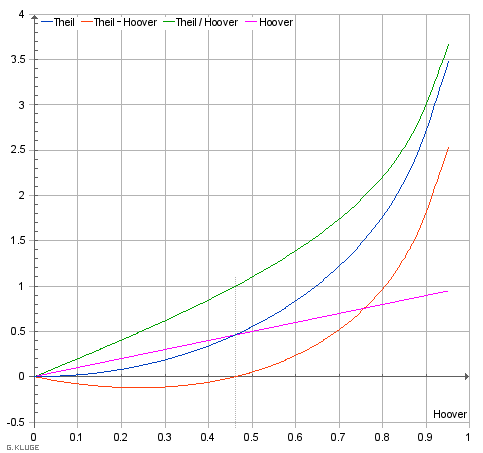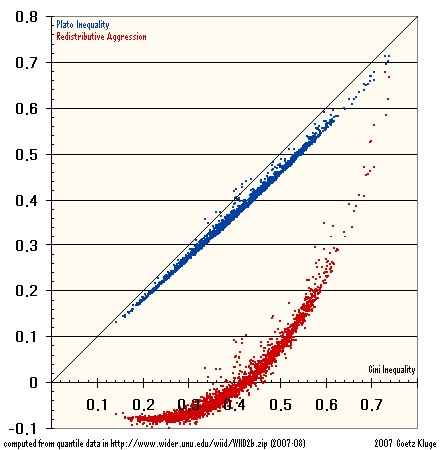 Relation between Theil Redundancy and Hoover Inequality for 2-quantile-societies. (For such societies, the Gini Inequality is equal to the Hoover Inequality.) |
Statements like the one above suffer not only from the lack of explanation how the Gini inequality was computed. You also want to know the sources. One approach is to look at the WIID database and to check, which countries are known for social unrest and what inequality measurements you get from these countries. Then you probably will agree to Liu Binyan's and Perry Link's statement. And I think, that also a redistributional aggression measure (which I introduce in the next paragraph) matches with the realities found between Scandinavian welfare and Latin American redistributional violence in the countries of the WIID database.
It is widely accepted, that property is distributed with a Gini index of 60%. How do you feel about that statement? Do you feel better with the statement, that in many cases 80% of the people own 20% of property and 20% of the people own 80% of property? You cannot reject the first statement and accept the second statement at the same time, as for such two-quantile-societies both statements are the same simplifications. Nevertheless, the 80:20 "Pareto Principle" is more than just a truism due to its proximity to 82:18, where the Theil redundancy is 100%. It seems to mark a frequent distribution of property and asset usage. Also we know, that a Gini index of 60% is related to more violent modes of redistribution. That is why property needs protection by law, police and physical barriers. As for incomes, distributions with a Gini index around 45% and below are what you expect in civilized countries without too much need to call in the police in case of conflicts. Whereas in case of property distribution a Theil redundancy of 1 should be checked for being a valid marking point, in case of income distribution the point, where Theil's redundancy and Hoovers inequality are similar, could be an interesting mark. Check the difference between both as a measure vor redistributive aggression.
If you question the 80:20-"principle" and reject giving a Gini inequality around 45% some special normative meaning, then you still can look for norms discovered by empirical research: Yoram Amiel and Frank Cowell[8] let students make judgements on sample inequalities. They "calibrate" inequality measurements empirically and also analyze, how the properties of inequality measures (anonymity, scale invariance, translation invariance, scale independence, translation independence, population principle, transfer principle and decomposability) are related to such judgements. This research gives sense to inequality measurement.
Outside of the lab, inequality rarely presents itself to the majority of people in quantiles or cake diagrams. Here empirical research could analyze, how happy people are with the distribution of ressources in their region. How important an issue is distributional justice? Should the government increase or decrease redistribution by taxation and other transfers? And if in a region there is something like a free press, you could analyze, how important inequality issues are to the media? This then could be correlated with measured inequalities and with the measured redistributive aggression (inequality issuization.)
